Duplex printing is a game-changer in document production. It changes how we handle our printing needs. In simple terms, it’s printing on both sides of a paper. This cuts down paper use and helps the environment.
Double-sided printing is a smart choice for those looking to use resources wisely. With modern printers, you can print on both sides of a sheet easily. This cuts paper use by about 50%.
This method does more than save money. It’s also good for the planet, uses less energy, and makes managing documents easier in work settings.
Key Takeaways
- Duplex printing reduces paper usage by up to 50%
- Modern printers have automatic double-sided printing capabilities
- Businesses can save approximately $200 per employee annually
- Reduces energy consumption compared to single-sided printing
- Supports environmental sustainability efforts
Understanding the Basics of Duplex Printing
Duplex printing is a new way to make documents. It lets you print on both sides of a sheet of paper. This method has changed how we make documents, making it more efficient and saving resources.
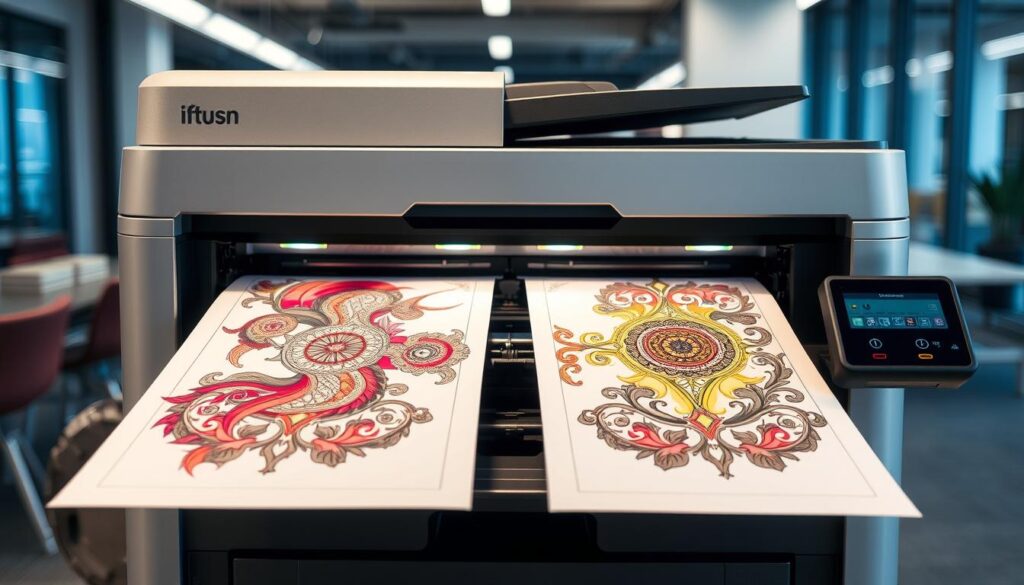
- Automatic Duplexing: Printers flip the paper for you
- Manual Duplexing: You need to flip the pages yourself
Types of Duplex Printing Methods
Today’s printing tech offers advanced options for printing on both sides. Automatic duplex printers make the process easy, saving time and boosting productivity.
| Printing Method | Speed | Complexity | Cost Efficiency |
|---|---|---|---|
| Automatic Duplex | High | Low | Excellent |
| Manual Duplex | Medium | High | Good |
How Double-Sided Printing Works
Two-sided printing uses special paper handling. Printers have rollers and sensors to flip pages right and make documents look professional.
Duplex printing can cut paper use by about 50%, making it good for the environment.
Key Components of Duplex Technology
Important tech parts make duplex printing work well:
- Advanced paper handling
- Smart software drivers
- Precision alignment sensors
- Efficient cooling systems
Businesses using duplex printing save money and work better.
What Is Duplex Printing
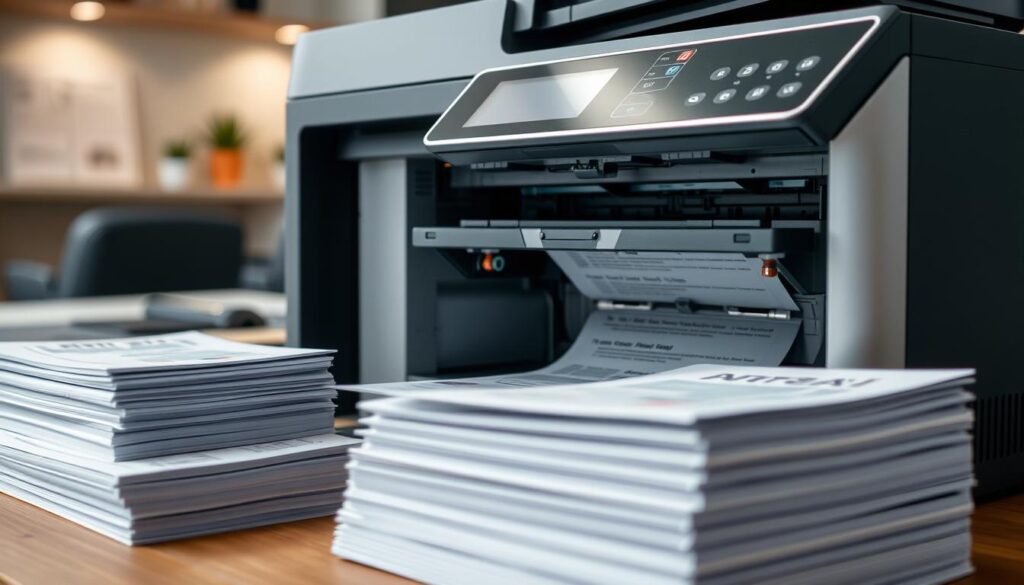
Duplex printing lets users print on both sides of a paper sheet automatically or manually. This method is a big step forward in making printing more efficient and eco-friendly.
“Duplex printing transforms how we approach document creation by maximizing paper usage and minimizing waste.” – Printing Technology Experts
This technology makes documents use both sides of a sheet, cutting down on paper use. Studies show duplex printing can cut paper use by about 50% compared to single-sided printing.
- Reduces paper waste dramatically
- Cuts printing expenses significantly
- Supports environmental sustainability
- Improves document management efficiency
More and more organizations around the world are using duplex printing. It’s not just good for the planet; it also saves money and makes things run smoother.
| Metric | Duplex Printing Impact |
|---|---|
| Paper Reduction | 50% decrease |
| Cost Savings | Up to 30% |
| Organizational Adoption | 60% of businesses |
Today, about 90% of multifunction printers can duplex print. Duplex printing is not just a feature—it’s a smart printing strategy.
The Evolution of Two-Sided Printing Technology
The journey of two-sided printing has seen a big change. It moved from manual to automated systems. This change has made document production faster and better in many areas.
Historical Development of Printing
At first, printing on both sides was hard. Printers had to flip pages by hand. This made printing slow and often wrong.

Modern Innovations in Duplex Printing
Today, printing on both sides is much easier. New technologies have made a big difference. These include:
- Automatic paper-flipping mechanisms
- Dual print engines for single-pass printing
- Advanced software integration
Future Trends in Two-Sided Printing
The future of duplex printing is exciting. We can expect even better things. These include:
- Printing faster
- Smart paper detection
- Using less energy
“The evolution of duplex printing represents a significant leap in printing technology, transforming how we create and manage documents.” – Printing Technology Experts
| Era | Printing Characteristics | Duplex Feature |
| Early Printing | Manual Page Flipping | Labor-Intensive |
| Modern Era | Automated Printing | Efficient Two-Sided Printing |
| Future Projection | Smart Printing Systems | AI-Enhanced Duplex Features |
Now, most printers can print on both sides easily. This has made printing faster and more eco-friendly.
Benefits of Printing on Both Sides
Duplex printing is great for saving paper and money. It helps both individuals and businesses manage documents better. It also helps the environment.
Printing on both sides saves a lot of paper. It can cut paper use by up to 50%. This makes it a green choice that saves resources.
- Reduces paper consumption by half
- Minimizes environmental footprint
- Decreases printing expenses
- Enhances document organization
It also saves money. Companies can cut paper costs and printing time by 50%. Less paper waste means more money saved.
“Duplex printing is not just a printing technique; it’s a strategic approach to sustainable document management.”
Duplex printing also makes documents look better. They are easier to read and take up less space. This makes them more organized and efficient.
| Benefit Category | Impact |
|---|---|
| Environmental Impact | 50% Paper Reduction |
| Cost Savings | Up to 50% Reduction |
| Storage Efficiency | Decreased Document Volume |
Choosing duplex printing is wise. It’s good for the planet and your wallet. It’s a smart way to manage documents.
Automatic vs Manual Duplex Printing
Duplex printing has changed how we make double-sided documents. It offers two main ways to do this. Knowing the difference between automatic and manual duplex can help you choose the best option.
Automatic Duplex Features
Automatic duplex printing is a big step forward in printing technology. It lets you print on both sides of the paper easily. The main features are:
- Single-click double-sided printing
- Built-in mechanisms for page flipping
- Seamless printing without manual intervention
- Ideal for high-volume printing environments
Manual Duplex Process
Manual duplex printing needs more effort from you. You have to take out and put back pages to make double-sided documents. Here’s how it works:
- Printing the first side of documents
- Manually flipping pages
- Reinserting pages to print the second side
- Carefully aligning pages to ensure proper printing
Choosing Between Methods
| Criterion | Automatic Duplex | Manual Duplex |
|---|---|---|
| Cost | Higher initial investment | Lower equipment cost |
| Time Efficiency | Faster printing | More time-consuming |
| Printing Volume | Best for high-volume printing | Suitable for occasional use |
Choosing the right duplex printing method depends on your needs. Businesses and professionals who print a lot will likely prefer automatic duplex. Those who don’t print much might find manual methods cheaper.
Duplex printing can reduce paper consumption by about 50%, making it a green choice.
Setting Up Your Printer for Double-Sided Printing
Double-sided printing, or duplex mode, is key for today’s offices and homes. It saves time, cuts down on paper, and makes printing smoother. Knowing how to set up your printer for two-sided printing is important.
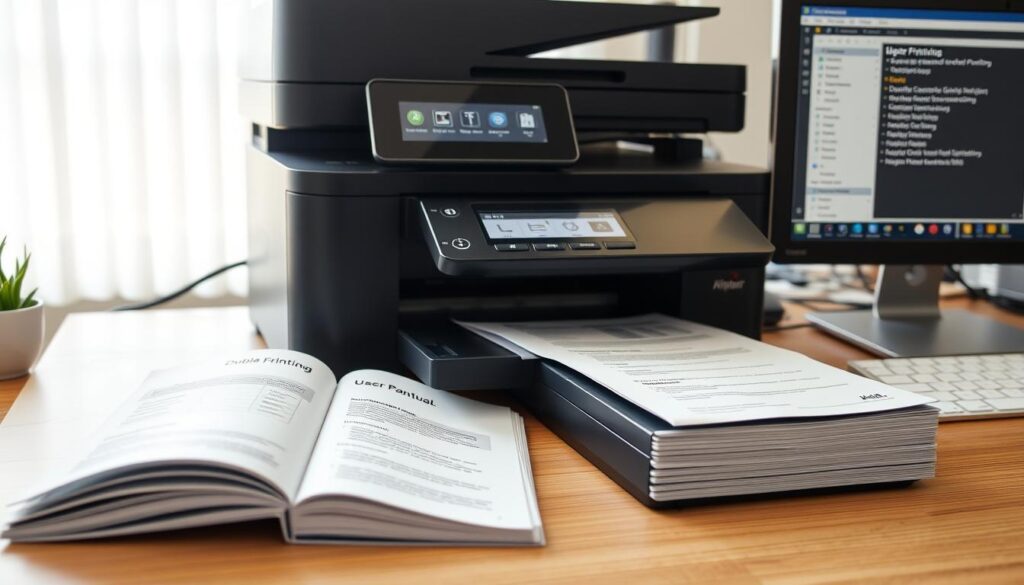
Setting up double-sided printing varies by your operating system and printer model. You can choose between automatic and manual duplex printing.
Windows Printer Configuration
- Open the Control Panel
- Navigate to “Devices and Printers”
- Right-click on your printer
- Select “Printer Properties”
- Locate duplex printing settings
- Enable two-sided printing option
macOS Printer Setup
- Click “File > Print”
- Find two-sided printing checkbox
- Select desired duplex mode
“Configuring duplex printing can reduce paper usage by up to 50%” – Printing Technology Report
Before you start duplex mode, check if your printer can do it. Look for a box-like thing on the back. It shows if your printer has duplex unit.
| Printer Type | Duplex Capability | Setup Complexity |
|---|---|---|
| Automatic Duplex Printers | High | Low |
| Manual Duplex Printers | Medium | High |
For the best double-sided printing, make sure your document is right. Also, your printer settings should match your needs.
Common Challenges and Solutions in Duplex Printing
Duplex printing has many benefits, but it also comes with challenges. Knowing these issues helps make the most of duplex printing. It also reduces problems during use.
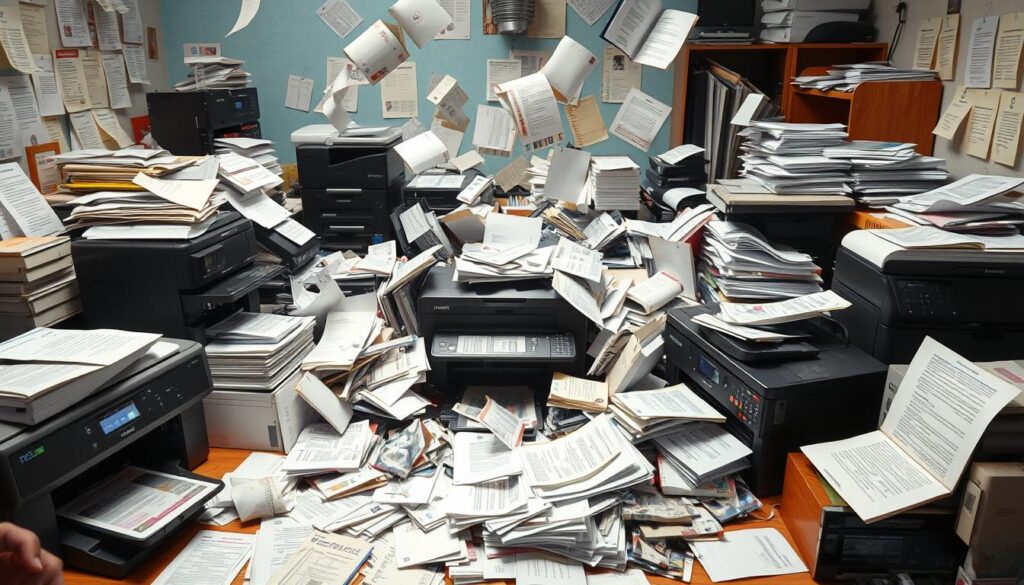
Paper Jams and Prevention
Paper jams are a big problem in duplex printing. Studies show double-sided printing can lead to a 20% increase in jams. To avoid these jams, users should:
- Use high-quality, recommended paper types
- Ensure proper paper alignment in input trays
- Regularly clean printer rollers
- Avoid overfilling paper trays
Print Quality Issues
Duplex printing can sometimes affect print quality. Ink bleeding and misalignment are common issues. To fix these problems, users can:
- Select appropriate paper weight
- Adjust printer settings for double-sided printing
- Use draft mode for internal documents
- Check ink or toner quality regularly
Troubleshooting Tips
Good troubleshooting can greatly reduce duplex printing problems. The Environmental Protection Agency says duplex printing can save 30-50% on paper costs if done right.
“Proper configuration and maintenance are key to successful duplex printing” – Print Technology Experts
- Perform regular printer maintenance
- Update printer firmware
- Train staff on proper duplex printing techniques
- Monitor print job settings
By tackling these common issues, organizations can make duplex printing better. This reduces waste and boosts printing efficiency.
Best Practices for Two-Sided Printing
Mastering duplex printing means knowing key strategies to make it better. Professionals can make document production more efficient by using smart approaches. This reduces paper use and boosts printing speed.
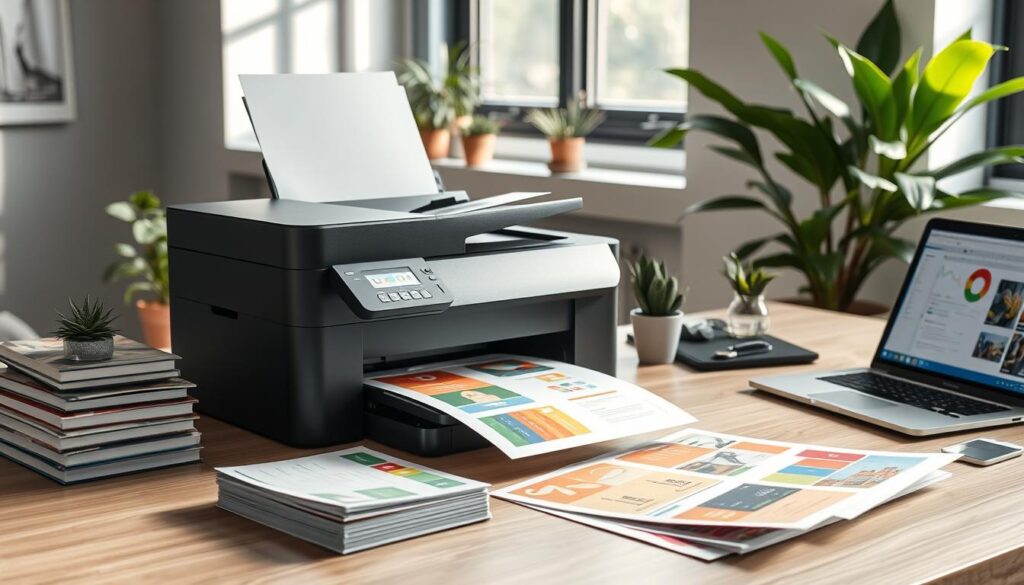
- Choose the right paper weight for even duplex printing
- Adjust printer settings for the best print quality
- Check the document layout before printing
- Know the different binding options
Companies using duplex printing see big benefits. Studies show it cuts paper use by up to 50%. This leads to big cost savings and helps the environment.
“Intelligent printing isn’t just about saving paper—it’s about working smarter.” – Printing Technology Expert
Here are key tips for great duplex printing:
- Make sure your printer can do duplex printing
- Calibrate your printer for the best results
- Use top-notch paper for two-sided printing
- Keep your printer in good shape for steady quality
Users can get the most out of duplex printing by learning special techniques. These improve document quality and lower printing costs.
Environmental Impact and Cost Savings
Duplex printing is a key way for companies to lower their environmental impact and save money. It’s about printing on both sides of paper. This method brings big benefits for the planet and the wallet.
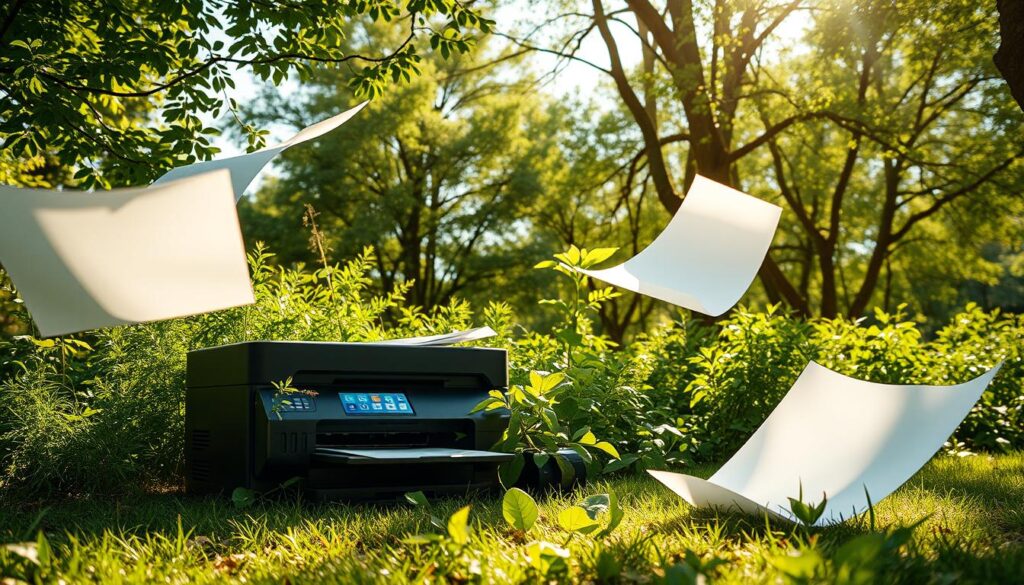
- It cuts paper use by up to 50%
- It lowers carbon emissions from printing
- It reduces landfill waste
- It helps save forests
Paper Consumption Reduction
Duplex printing helps companies use less paper. Studies show a single company can save about 3 million tons of paper each year. This big cut helps keep forests intact and lowers emissions from paper making.
Financial Benefits
The money-saving side of duplex printing is just as good:
- It cuts paper costs by 50%
- It lowers costs for storing and shipping
- It saves about 40% on toner
- It boosts work efficiency
Environmental Sustainability
“Duplex printing is not just a printing technique; it’s a commitment to sustainable business practices.”
Companies that use duplex printing show they care about the planet. This tech saves resources and cuts energy use by up to 20%. It’s a smart move for businesses that want to be green.
Choosing the Right Paper for Duplex Printing
Choosing the right paper is key for good duplex printing. Not all papers work the same when printing on both sides. Knowing about paper types helps get the best double-sided printing results.
When picking paper for duplex printing, think about these important points:
- Paper weight and thickness
- Opacity to prevent show-through
- Printer compatibility
- Document purpose
Thicker papers with high opacity are best for duplex printing. Heavier paper weights between 24-32 lb help avoid ink bleeding and reduce page transparency. Businesses can cut paper use by up to 50% with duplex printing.
“The right paper transforms double-sided printing from a challenge to an advantage.” – Printing Technology Experts
Different types of documents need special paper:
- Professional reports: High-opacity, bright white paper
- Academic documents: Slightly textured, durable paper
- Marketing materials: Glossy or coated paper
Now, about 60% of modern printing needs are met by automatic duplex printers. So, picking the right paper is more critical than ever for quality prints.
Document Design Considerations for Two-Sided Printing
Designing documents for two-sided printing needs careful planning. This ensures the results are professional and easy to read. The duplex mode requires a strategic approach to layout, margins, and page elements. This is to create seamless double-sided documents.
- Paper orientation alignment
- Consistent margin management
- Strategic page numbering
- Balanced graphic placement
When making documents for two-sided printing, designers face several key factors:
- Choose the right paper weight (24 lb/90 gsm is recommended)
- Make sure margins are set correctly
- Plan where to put headers and footers
- Optimize where to place graphics and text
“Effective duplex printing transforms document design from simple page layout to strategic visual communication.”
The printing orientation greatly affects how readable a document is. Long Edge Feed orientation gives the best results. It minimizes alignment issues during two-sided printing.
| Design Consideration | Impact on Two-Sided Printing |
| Paper Weight | Prevents ink bleed-through and ensures crisp printing |
| Margin Consistency | Maintains professional document appearance |
| Graphic Placement | Prevents content overlap between pages |
Professional document design in duplex mode needs attention to detail. It also requires understanding of printing technology’s limitations and opportunities.
Tips for Professional Double-Sided Documents
Creating professional double-sided documents needs careful planning and detail. Duplex functionality has changed document design. It offers both beauty and practical benefits for businesses and individuals.
Layout Optimization Strategies
Successful double-sided printing requires smart layout design. Designers should follow these key tips:
- Keep margins the same on both sides of the document
- Choose fonts that are clear and easy to read on both pages
- Make sure the design looks good on both sides
- Print drafts to check how the content looks
Margin Adjustments for Professional Results
Getting the margins right is key in double-sided printing. Experts suggest these margin tips:
- Give extra space near the binding to avoid losing text
- Make inner margins wider for bound documents
- Change margin sizes based on the binding method
Binding Considerations
Each binding method needs a special approach to double-sided printing. Here are some expert tips:
| Binding Type | Margin Recommendation | Content Placement |
| Spiral Binding | 0.5-0.75 inches | Avoid critical text near spiral holes |
| Perfect Binding | 0.25-0.5 inches | Center content with slight inner margin |
| Saddle Stitch | 0.25 inches | Minimize content near fold |
“Precision in double-sided printing transforms ordinary documents into professional communication tools.” – Print Design Expert
By using these duplex printing techniques, professionals can make documents that look great and work well. These documents are both beautiful and useful.
Conclusion
Duplex printing is more than just printing on both sides of a page. It’s a game-changer that helps save paper and the environment. It’s a key feature for businesses, schools, and homes looking to print smarter.
Studies show duplex printing can cut paper use by up to 50%. This leads to big savings and helps the planet. Today, over 70% of printers can print on both sides automatically. Companies like G&G show how fast and efficient these printers can be.
As technology gets better, duplex printing will too. We’ll see better energy use, easier document handling, and clearer prints. Using duplex printing helps the planet and makes life easier for everyone.
The future of printing is all about two-sided tech. Duplex printing is leading the way to smarter, greener printing. It’s great for work, school, or personal projects, making printing more efficient and eco-friendly.
For more details, visit: https://oaksrealestateteam.com/property-evaluation/

